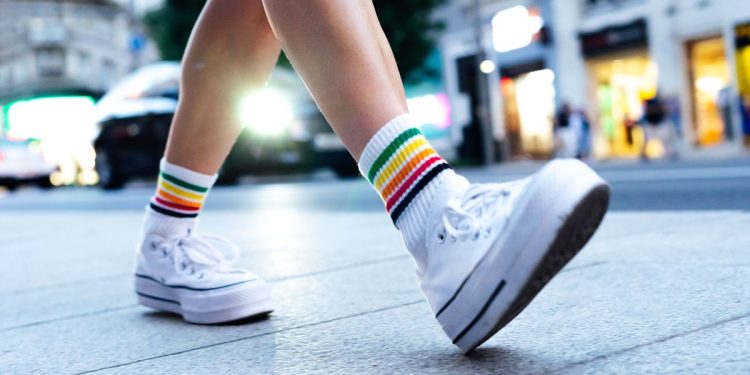Foot problems can be particularly debilitating. Think of the frequency that most of us need to use our feet throughout the day while we are going from point A to point B.
This is why it is important to do what we can to keep our feet healthy and work – especially by avoiding certain shoes and behaviors.
“As a podiatrist, we literally see the worst foot case,” HuffPost Huffpost told HuffPost. “Naturally, there are things that we abstain from doing what we know.”
Below, Vincent and other feet and ankle health experts share the behavior they avoid in order to protect the health from their foot.
Wear fangs everywhere
In recent years, the fangs have returned to the style – to many sorrow podiatrists.
“Don’t get me wrong, the fangs are a decent shoe to wear in the house or by doing small tasks,” said Vincent. “However, when I see people carrying fangs in Disneyland or for long hours of position, I know they will probably suffer from certain foot problems all over the line.”
She recommended carrying “a good walking shoe” of brands like Brooks, Asics or New Balance for long days of standing or walking position.
Live in high heels
“Women who live in high heels will eventually suffer from pain pain from onions, corns, heel spurs or even Achilles tendon pain,” said Vincent.
Many people like to put high heels for special occasions, so wearing these shoes is not a “never” behavior. However, a healthy balance is crucial. We are not Barbie, after all.
“You should wear high heels (in) moderation, not all day or every day,” said Dr. Jason Gold, a podiatrist certified in the foot board, ankle and vein center legs in Florida. “Wearing high heels causes your foot pronation, which can cause onions, hammer toes or plantar fasciitis.”
In general, he tells patients with pain in the foot to wear a support shoe at least 80% of the time. For the remaining 20%, they can wear the shoe they would like. He noted that platform heels can help reduce stress on the foot and muscles on the leg.
Naked
“During the coconut, people started working at home much more than ever,” said Gold. “I found that it caused more foot and ankle problems because people have stopped wearing shoes as often.”
He recommended having a pair of supporting support sneakers when you walk home, especially if you are on tiles and marble more than the carpet. You can buy a specific home sneaker for use inside only if you are anxious to bring in germs from the outside.
“Many and many times we hear that people live on foot and are supposed to be comfortable in this way,” added Vincent. “If you do not constantly provide your support for your feet, you will develop calluses or even an atrophy of fatty pads. If this happens, walking barefoot will no longer be comfortable and you will limit your options on the shoes you can wear in the future.
Run in Non -Courino shoes
“Avoid running in shoes that are not racing shoes,” said the Atlanta -based podiatrist, Dr. Jay Spector. “Many people will have a pair of cheap shoes and try to run, which can create pain.”
He recommended changing your racing shoes every 300 to 500 miles or every six to eight months.
“Also, wear the right shoe for the right activity,” added Spector. “Avoid wearing racing shoes to play tennis and vice versa.”
Dr. Michael J. Trepal, professor of surgery and academic dean at the New York College of Podiatric Medicine, warned not to wear zero shoes (in which your heel is not high, but at the same level as your toes) Or run barefoot.
“Not only can a naked foot submit the skin at the bottom of the foot to the injury, but (it) also supports the poor mechanics against an undisable soil,” he said.
Go barefoot in hotel bathrooms and other germs areas
Even if the idea of going barefoot in the bathroom in a gym, a hotel or another public place does not give you off, the podiatrists would always advise it.
“I never walk barefoot in a hotel where I take showers without flip -flops to avoid the chances of wans / verruca or exposure to the foreign body,” said Gold. “Walking barefoot in a hotel or public places increases your chances of obtaining a virus on your feet, which is known as the Verrue or Verruca of a plantar. Warts can multiply and become quite large on the foot and are sometimes difficult to remove. »»
Wearing cotton socks
The fabric of your socks can also make a difference in terms of feet health, noted Spector.
“Avoid wearing cotton socks because they keep moisture and can cause bulbs and mushrooms on foot and nails,” he said. “Get the synthetic materials, because they evolve sweat and humidity.”
Go to unreliable manicure salons
“I would never go to a living room that would not sterilize their instruments after use, which helps to avoid the chances of fungal or bacterial infections,” said Gold. “Fungal infections will seriously train the nails seriously thickened and discolored over time.”
Make sure you go to salons that follow hygiene and cleanliness standards you can trust.
“Do not … Soak your feet with a pedicure without lining, and make sure you see them open instruments that have been in an autoclave,” said Spector. “We see a lot of what I call” post-pedicure syndrome “where we have seen stapal infections of Rarm, embodied nails and feet cellulite.”
Self-treatment or ignore infections
“I would not recommend using products such as nails from the entry into embodied nails, because it is an acid that can cause greater infections,” said Spector. “In addition, with an infection like an embodied nail, I did not swim in a lake or a river where you do not know what are the levels of E. coli.”
Trepal has also advised self-treatment of embodied nails due to the risk of infection and other complications.
“I wouldn’t be aware of the foot pain either because it could be a sign of something more serious,” he added.
Do not remove the laces
“Especially in pediatric patients, I would avoid opening laces and withdrawing them when setting up,” Trepal said. “The shoe support function is lost or considerably reduced in an unrelated or stored shoe.”
He noted that this is particularly true with a type of flat or low arch, as these are subject to symptoms in development with inadequate support.
Forget to take additional care as diabetics
“People with diabetes should never go barefoot,” said Vincent. “Indeed, diabetes can damage the nerves of your feet. Do not wear shoes puts you in danger of injuries to the bottom of your feet that you may not feel due to the loss of feeling of nerve lesions. About 1 in 5 people with diabetes who go to the hospital do it for foot problems. »»
Go without advertising – and protect the free press
Support HuffPost
Already contributed? Connect to hide these messages.
She recommended inspecting your feet daily and wearing support shoes that adapt correctly to avoid complications.
“I would receive periodic professional examinations if I suffered from diabetes or bad circulation,” said Trepal, adding that he would never use a heating cushion or place his feet on a radiator if they had these conditions, because the Limited sensation means an increased risk of burning the feet.


